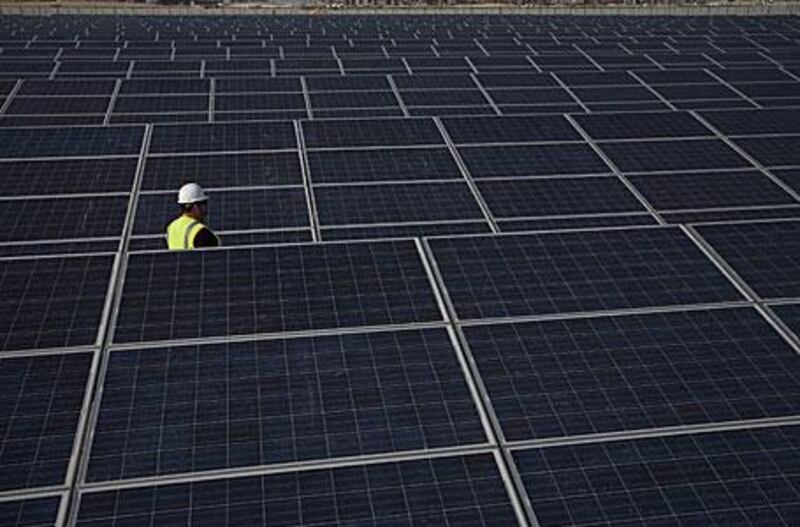ABU DHABI // The country's first solar power plant is cranking up its energy-generating performance following last week's dusty weather, which reduced its output by as much as 40 per cent. Built for Masdar, the Abu Dhabi Government's sustainability initiative, the power plant is capable of converting sunlight into energy without emitting carbon dioxide or other gases responsible for global warming.
But the fact that this technology relies on natural factors makes it vulnerable to the weather. Last Sunday, when the amount of suspended dust in the air was between 1,500 and 2,000 parts per million - more than 10 times higher than normal - the plant functioned at 60 per cent of its capacity, said Khaled Awad, director of Masdar City, the world's largest carbon-neutral urban development now being built on the outskirts of the capital.
"There have been several sand storms since the plant was commissioned earlier this year, though this has been one of the longest," said Mr Awad. "Dust storms are a normal part of life in the desert. We anticipated this type of weather when we began construction of the plant and it therefore does not impact our operational strategy." Masdar's plant has a capacity of 10 megawatts - enough to power some 8,000 homes - and saves 15,000 tonnes of carbon dioxide from being released into the atmosphere every year.
It consists of rows of photovoltaic solar panels, made of specialised semiconductor materials, which turn sunlight into electricity. The installation consists of 87,777 solar modules spread over 200,000 square metres - an area the size of 27 football pitches. The modules were supplied by two companies - Suntech Power Holdings, from China, and First Solar, an American company. Both types were evaluated in a performance review that Masdar carried out before construction of the power plant began.
"We conducted extensive testing of the panels' performance in these harsh desert conditions," said Mr Awad. "Our testing facility, which is still running today, collected performance data for over 18 months. The plant's power output was estimated based on the data obtained. "Over the course of a year, the plant's average daily output is 47,945 kilowatt hours. "This varies throughout the year. For example during the summer months, when the days are longer, the output is higher than during the shorter winter days."
The plant's solar panels had been cleaned on Thursday and output was back to normal. Mr Awad said the experience over the past week was not likely to cast a shadow over Abu Dhabi's plans for solar power. In January this year, the Government announced that by 2020, seven per cent of the emirate's power would come from renewable sources. In addition, Masdar City, which is now being built, will rely mostly on the sun for its energy supply.
Despite the occasional sand storm, Abu Dhabi is better positioned to reap the benefits of solar power than many European countries, including Germany, which is one of the world leaders in the field. "Dust storms have the same impact on a PV panel's performance as cloud cover," he said. "In Abu Dhabi, we have a number of dust storms during the year, but compared with the level of cloud cover European countries such as Germany receive, the performance in Abu Dhabi is far superior.
"In fact, on average, a solar module installed in Abu Dhabi will generate twice as much as a cloudy region in Europe. "Abu Dhabi has some of the world's best solar resources and we expect to see this technology widely adopted in the region." Ray Noble, a photovoltaic expert with the Renewable Energy Association in the United Kingdom, expressed a similar opinion. "With a little bit of maintenance, your average output can be better than that in other parts of the world," said Mr Noble, who is due to visit the UAE later this month for a series of workshops organised by Gulf International Trading Group.
Mr Noble is working with the Sharjah company to promote the use of a specially developed laminated glass that incorporates solar cells. The product can be used in buildings - in windows, roofs, atria and façades - to generate electricity. "Throughout the year, an area equivalent to seven square metres of solar panels will generate 1,750 kilowatt hours in the UAE," he said. "The same area in Germany will generate 1,100 kilowatt hours per year.
"In Germany, you have less sunshine and more cloudy days and this is causing the difference in overall performance." So what is the future of solar photovoltaics in the UAE and how can the impact of sand storms be minimised? Mr Awad said Masdar was looking into "various automated cleaning methods to expedite the cleaning of the PV modules". "We are also exploring different PV panel coatings, which will either eliminate or minimise dust settling on the panel surface," he said.
But will that be enough to guarantee the future of Masdar city which will be inhabited by 90,000 people when it is finished in 2016? The US$22 billion (Dh81bn) development will be using photovoltaic panels in buildings as well as other solar technologies to provide most of its power. Mr Noble said that for any development there were two ways to achieve smooth operation. One was to have a connection to the main electricity grid, drawing power from it when necessary and feeding it back at times of surplus production.
The other method involved the use of advanced design and technologies to store power and use that when generation was low. Ultimately, though, Mr Noble believes the future of solar power lies in using it to extract hydrogen from water and using that as fuel. vtodorova@thenational.ae





